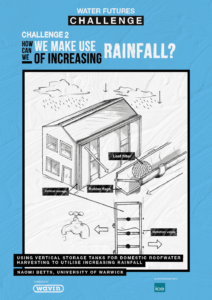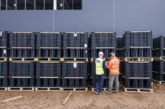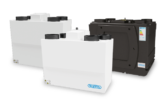As part of plumbing and drainage manufacturer Wavin’s Water Futures Challenge, engineering students and junior engineers across the UK were tasked with proposing radical solutions to four of the built environment’s most pressing water-related issues.
In this piece, Martin Lambley, Head Judge for the challenge and Wavin Product Manager – North West Europe, UK, and Ireland, outlines his thoughts on the UK’s water crisis, and Water Futures Challenge finalist Naomi Betts explains how her entry to the competition helps address these challenges.
Martin Lambley outlines his thoughts on the water crisis…
Despite wetter winters and increasing instances of heavy rainfall, our water reserves are lower than ever. The UK experienced its longest dry spell in 50 years this summer, and hosepipe bans were introduced across the country. Concerns over water availability dominated the news agenda and it is clear the built environment needs to drastically alter how it thinks about water, while reacting faster to climate change.
We should treat water as a precious asset rather than a disposable commodity, by reusing it where there is too little, filtering where it is too polluted, and returning it to the ground when groundwater supplies are depleted. There is an urgent need to start collecting and saving water during these sporadic periods of heavy rainfall, to build resilience in anticipation of future dry spells. A circular mentality must underpin every urban design step we take.
Wavin’s Water Futures Challenge, which was run in collaboration with the Institution of Civil Engineers (ICE), aimed to draw out and discuss ideas which follow this way of thinking. Focusing on the four pillars of Wavin’s purpose of building healthy, sustainable environments, it challenged engineering students and junior engineers to come up with radical solutions to key water-related issues. These included solutions to support safe and efficient water supply, better sanitation and hygiene, better building performance and climate resilient cities.
We’re delighted that engineering student Naomi Betts from the University of Warwick was shortlisted with her idea on how to make use of increasing rainfall through roofwater harvesting. While these types of systems do already exist, they are rarely implemented in the UK. There are a number of reasons for this, including a lack of space, a long payback period, and a debate over the scale of water scarcity.
Naomi Betts explains her idea of a domestic roofwater harvesting system…
My idea is to implement a domestic roofwater harvesting system that comprises a vertical water storage tank that feeds straight from the gutter and sits flush to the side of the house. This means there is no need for a downpipe and helps to keep the system tight within the footprint of the property. This is important given that a lack of space is one of the main challenges for implementing roofwater harvesting in the UK.
The tank’s outlet would be at one end of the property, so that all of the water enters the house through one inlet, passing through a chemical filtration system. This would allow water to be pumped directly to toilets, sinks, washing machines – essentially providing around 25-30 litres of greywater daily per person for the average UK household. Typically, about a third of household water is used for flushing the toilet, so reclaiming greywater for this purpose can offer significant savings.
The gutter itself would need to incorporate a number of features to prevent contamination of the system, such as mesh filters and bird deterrents to minimise required maintenance. Monitoring and maintenance of the system could also be digitised, perhaps through an app, in order to make it as easy as possible for homeowners to manage their water. This is a crucial step, because encouraging buy-in from homeowners is a key factor in delivering this type of solution.
Cost is another barrier that will always be a challenge when introducing new systems. Typically, domestic rainwater harvesting has a payback period of around 14 years, although due to the intricacy of my proposed system this could be closer to 20 years. It should be stressed that this is very much dependent on water tariffs, which are unlikely to remain at current levels due to increasing water scarcity. If the price of mains water increases, then the overall payback time to the end user will be reduced.
This is where government-incentives, such as those we have seen in recent years for renewable heating, will have an important role to play in encouraging homeowners to adopt this type of system. Rainwater harvesting does far more than reduce water bills – it helps to mitigate flooding by reducing the amount of water entering our sewers during heavy rainfall, and improves water availability during sustained dry periods.
Martin Lambley continues…
Naomi’s idea was shortlisted because it honed in on one of the main barriers to wider implementation of rainwater harvesting – space. The use of vertical storage tanks was an innovative approach, especially for updating existing housing stock. The link with utilising rainfall for greywater makes a compelling case and is one that could conceivably help to drive uptake among the general public.
However, as Naomi outlined, cost is something that will always be an obstacle when introducing a system with such a long payback period. Homeowner buy-in is another – will people accept this radical change to their home’s exterior? Questions remain over the practicalities of structural integrity, given the potential weight on the side of a home, and the durability of the materials involved would need to be assessed.
Rainwater harvesting is something that could have a significant impact on how we tackle the impact of climate change and overcoming these barriers will be central to increasing our ability to harness intense rainfall.
Ultimately, it comes back to altering our mindset towards water – to harvest is to make use of this valuable resource, rather than trying to remove it as quickly as possible. A sophisticated approach to managing water is therefore critical to the long-term health of our infrastructure.
Droughts, flooding and intense rainfall are all interlinked issues, and are predicted to continue and even worsen in the years ahead. Rainwater harvesting is an interesting piece of the puzzle, which alongside the other solutions outlined in the Water Futures Challenge, could help to combat the growing water crisis.









